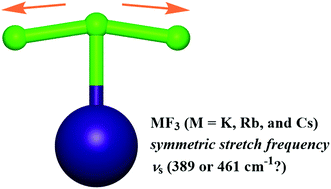Vibrational frequencies, structures, and energetics of the highly challenging alkali metal trifluorides MF3 (M = Li, Na, K, Rb, and Cs)†
Abstract
Many experimental studies have been reported on alkali metal trifluorides MF3 (M = Li, Na, K, Rb, and Cs), and several controversies remain. In the present research, we systematically study the MF3 systems using both coupled-cluster and multireference methods. New predictions and explanations are provided for some known experimental and theoretical challenges, including identification of the true MF3 minima and global minima, the unclear existence of light alkali metal trifluorides MF3 (M = Li and Na), and assignment of the F–F–F symmetric stretch frequencies for the heavier alkali metal trifluorides MF3 (M = K, Rb, and Cs). With several new structures located, we predict a preference of Cs minima for MF3 (M = Li and Na) and C2v minima for MF3 (M = K, Rb, and Cs). For the species where multiple minima were located, near degeneracies of those minima can be found in most cases. The endothermicities (∼3–4 kcal mol−1) for the favored MF3 → MF + F2 fragmentations suggest that MF3 (M = Li and Na) are weakly bonded complexes. The existence of those species at low temperatures cannot be ruled out, and vibrational frequencies are reported to guide future experiments. Most importantly, significant differences between the coupled-cluster and multireference results were found in predicting the F–F–F symmetric stretch frequencies (νs) of the C2v MF3 (M = K, Rb, and Cs) structures, although both methods show good performance in predicting most structures and antisymmetric stretch frequencies (νas). The coupled-cluster [CCSD(T), CCSDT, and CCSDT(Q)] results agree with the recent experimental assignment of Redeker, Beckers, and Riedel [389 cm−1, RSC Adv., 2015, 5, 106568] to the νs fundamental of CsF3. In contrast, the multireference (CASPT2, CASPT3, and MRCISD+Q) results support the original experimental assignment of Ault and Andrews [461 cm−1, J. Am. Chem. Soc., 1976, 98, 1591; Inorg. Chem., 1977, 16, 2024]. The F–F–F symmetric stretch frequencies for the MF3 molecules (M = K, Rb, and Cs) continue to provide a great challenge to theory and experiment.

- This article is part of the themed collection: 2018 PCCP HOT Articles


 Please wait while we load your content...
Please wait while we load your content...
